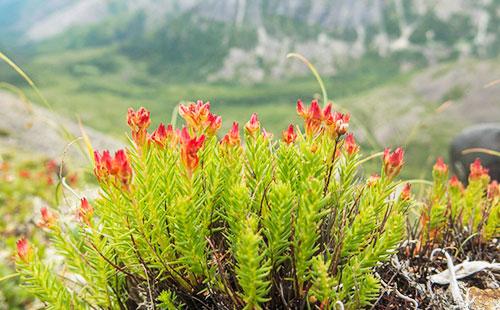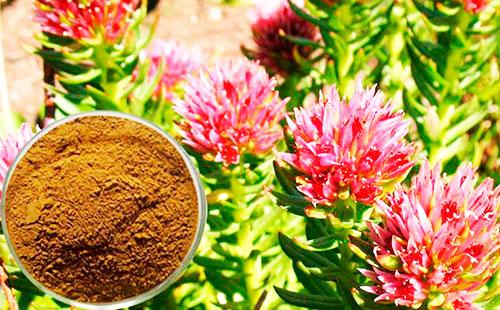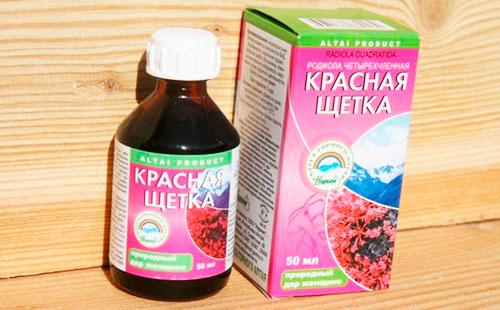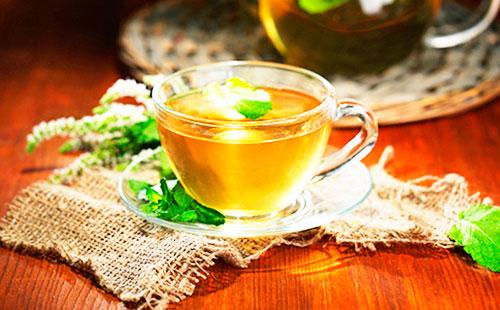The content of the article
The healing properties and contraindications of the red brush were discovered by Altai shamans. After all, Altai is considered the birthplace of this medicinal plant. From Altai healers came valuable knowledge and recipes for the preparation of potions from the herb-healer. The plant is listed in the State Pharmacopoeia and is widely used in medical practice. To achieve a therapeutic effect, it is important to know how to take a red brush and brew properly? What drugs can it be combined with? When is this herb strictly contraindicated?
Features of the red brush with photo
To date, the four-leaf radiola for women has been included in the Red Book of Yakutia, Buryatia, Mongolia, and its collection is prohibited on an industrial scale. In most Siberian reserves, the plant is under protection. The disappearance of this culture is associated with active industrial gathering, in addition, the plant itself is a rare species.

Area
Grass red brush - "resident" of the rocky terrain, loves rocky soil. It is believed that it was the mountain climate and adverse conditions for survival that made this herb a medicinal raw material with a unique chemical composition. In Russia, it is most often found in the Altai Mountains and the Eastern Sayan Mountains. It is also distributed in China, Pakistan, Kazakhstan, Mongolia. Some species of this herb are registered in the botanical catalogs of North America. Rarely, but still you can see this plant in the Alps.
Botanical Description
Four-membered Rhodiola is the scientific name of the plant. About 65 species of this culture are described. What is a four-membered rhodiola? This perennial herb is spherical in shape, grows up to only 15 cm. The root and rhizome are well developed, at the top they form a powerful stem on which last year's red stems remain. The root has a pleasant aroma similar to the smell of a rose. Many vertical young stems with linear, lanceolate leaves depart from the main stem. On the tops of the stems are corymbose inflorescences. They form from 3 to 5 small, yellow, with a reddish top of the flowers. Grass blooms in June-July.

Composition and pharmacological properties
The herb has an impressive list of “virtues” and a wide range of pharmacological effects.
- Useful substances in the composition: phytohormones, sterols, glycosides, waxes, sugars, phenols, essential oil, flavonoids, organic acids, betaines, tannins, vitamins and a unique complex of trace elements (molybdenum, selenium, manganese, chromium, silver, zinc, cobalt).
- Pharmacological properties: anti-inflammatory, hormonal, wound healing, antiseptic, laxative, analgesic, immunostimulating, hematopoietic, vasoconstrictor, stimulating, antitumor, astringent, antibacterial, antiviral, antifungal, regenerating, anticarcinogenic, adaptogenic.
The chemical composition and healing properties of the herb continue to be studied.In the plant, substances called "anthocyanins" were found that are able to fight bacterial, viral and fungal infections.

Indications and contraindications
What are the indications for using grass red brush?
- Gynecology. In this area, grass is used as a universal remedy for a wide range of female diagnoses: infertility, ICPmenopause syndrome, menstrual irregularities, amenorrhea, erosion andcervical polyps, ovarian cysts, fibroids and their varieties, endometriosis, mastopathyinflammation of the appendages.
- Urology. Cystitis and pyelonephritis are successfully treated.
- Endocrinology. The list includes hypothyroidism, thyroid inflammation, diabetes mellitus and other diseases.
- Gastroenterology. Grass improves digestion and peristalsis, helps with constipation and dysbiosis.
- Cardiology. The grass helps in the treatment of cardiovascular diseases, lowers cholesterol and blood pressure, strengthens blood vessels. Also, the plant is effective for diseases of the blood, lymph.
- Neurology. The grass helps relieve bouts of hysteria, epilepsy, it is drunk with a concussion, neurosis.
- Otolaryngology. Treat sinusitis.
- Traumatology. With skin lesions and injuries (fractures, bruises, wounds) lotions are made.
- Oncology. There are studies confirming the antitumor properties of grass. It is also prescribed as a general strengthening, immunostimulating agent for the restoration of the body.
Useful red brush for men. It is used to treat adenoma, prostatitis, infertility. Grass enhances potency, increases sperm motility, relieves pain, normalizes hormone imbalance. Four-membered rhodiola is useful for men of mature and old age, when there are signs of age-related androgen deficiency ("male menopause").

Contraindications of the red brush:
- allergy, individual intolerance to the drug;
- pregnancy at any time;
- lactation period;
- menstruation (there are exceptions when the doctor prescribes a herb to treat pain symptoms during menstruation, with heavy discharge);
- temperature rise;
- high blood pressure;
- persistent depression, insomnia;
- children under 18 years old.
During treatment excluded: fatty, spicy foods and alcoholic beverages. It is advisable not to take the drug in the evening, in order to avoid nervous system excitement before bedtime.
Application in traditional medicine and pharmacology
Four-membered Rhodiola is one of the most popular female herbs. You can prepare medicines from this plant material at home. But you can also buy ready-made drugs at the pharmacy.

Pharmacy preparations
- Alcohol tincture of a red brush. The tincture contains rhizome, red brush root and ethyl alcohol. Bottles come in 30, 50 and 100 ml. In addition to the female genital area, indications for use are diseases of the endocrine and nervous system. Instructions for the use of tincture of the red brush says: the medicine is drunk for diseases of the adrenal glands, lymph nodes, anemia, leukemia, atherosclerosis; the drug relieves spasms of the brain, has hemostatic properties; the average daily dose of tincture is 100 drops when taken three times.
- Tea. In the pharmacy you can buy one-component tea with four-membered Rhodiola. But also grass is often included as a component in women's fees. The list of indications is the same: gynecology, endocrinology, neurology, cardiology.It is a mild antidepressant, also a mild diuretic, sedative, antispasmodic, hypertensive (pressure-reducing) drug. The drink has a rejuvenating effect.
- Balm. A multi-component oral preparation. Accepted in small doses - 1 tsp. three times a day. The course of treatment depends on the diagnosis. Balm can be taken no more than 6 weeks. Drink for the prevention of oncology, spasms of cerebral vessels.
- Syrup. A tasty medicine, however, is contraindicated for diabetics because of sugar. The medicine is taken for 4 weeks, if necessary, repeat the course. This is a good adaptogenic and immunostimulating agent.
- Pills. Assigned as dietary supplements for the prevention and strengthening of the body. They have many vitamins, minerals and flavonoids. Peculiarities of taking: 2 tablets are taken once a day up to 14 hours (with meals!), Washed down with plenty of water.
- Grass. It can be freely bought at the pharmacy. From it you can prepare an infusion, broth or alcohol tincture.
- Drops "Femofit." The tincture contains extracts of a red brush and a pine uterus. The tool is effective in treating fibroids, fibromas, infertility (including male ones), mastopathy, cystitis, uterine bleeding, pelvic inflammation. In combination, these herbs increase the body's resistance, strengthen immunity, and provide a rejuvenating effect.

Gynecology
No matter how wonderful the properties of the four-membered rhodiola, its independent use can harm the female body and add new ones to the old diagnoses. After all, it is a natural hormone! What diseases are most commonly prescribed for grass?
- Red brush when planning pregnancy. The grass in the component with the boron uterus is often prescribed for infertility. Read more about the use of the uterus in gynecology in our other article. Rhodiola four-membered has adaptogenic properties, strengthens the female body as a whole, therefore it is often prescribed when planning pregnancy, for the prevention of female infections and hormonal imbalance.
- Mastopathy Mastopathy is a benign proliferation of connective tissue in the mammary gland. The most common cause of this diagnosis is hormonal failure. The four-membered Rhodiola not only normalizes the hormonal background (first of all, prolactin levels are restored), but also acts as an anti-inflammatory and analgesic, relieves pain and promotes resorption of nodes.
- Climax. In the menopause, women experience a number of unpleasant symptoms: malfunctions of the menstrual cycle, uterine bleeding, painful periods, hot flashes, nervousness, depression, tearfulness, a sharp change in mood. The grass not only regulates the hormonal background, but also acts as an antidepressant, improves mood, normalizes sleep and appetite.
- Endometriosis With a pathological proliferation of endometrial cells on the walls of the uterus, the gynecologist prescribes conservative treatment. And in complex therapy often include female herbs - a red brush and a pine forest. One of the causes of pathology is an excessive increase in estrogen in the first phase and very low progesterone in the second. The four-membered rhodiola helps to resolve this imbalance and reduces estrogen levels. If a cycle failure is detected with this diagnosis, then the rhodiola is prescribed in the first phase of the menstrual cycle, and the boron uterus in the second.
- Myoma. This is a common diagnosis. One of the first causes of a benign tumor in the uterus is hormonal imbalance. The success of treatment depends on many factors: the size of the fibroids, the age of the woman, complex therapy, the frequency of relapses, the state of the immune system, lifestyle, nutrition, and emotional state.
- Inflammation, infections of the genitourinary system. At thrushinflammation of the vaginal mucosa, ureaplasmosisbacterial infections recommended douching with a decoction of grass. For the procedure, you need to take 1 tsp.decoction for half a liter of warm boiled water. You can not use concentrated decoctions, this can lead to a violation of the microflora of the vagina. Douching is necessary in the morning and evening for 7 days. After this, a break is made for one week, then the course is repeated.
Most often, in the treatment of gynecological diseases, the doctor prescribes tests for hormones that must be taken on an empty stomach on certain days of the cycle. This helps the gynecologist to determine the hormonal background and prescribe adequate hormone therapy.

Features of the preparation and reception
How to brew a red brush? There are several general rules for the preparation and storage of decoctions, infusions and tinctures from herbs.
- Decoctions and water infusions can be stored for no more than 2 days in the refrigerator, with further use the grass loses valuable properties.
- After cooking, decoctions, infusions and alcohol tinctures need to be filtered.
- The grass is not poured with boiling water (the temperature should not be higher than 80 ° C), do not boil, but only steamed or kept in a water bath.
- Alcohol tinctures are preferable to do on alcohol (40%), and not on vodka.
- Alcohol tinctures can be stored throughout the year in a dark, cool place, in tightly closed glassware.
Cooking broth
- Pour 2 cups of hot water (80 ° C) 1 tbsp. l herbs.
- Cover, place in a water bath.
- Soak for 5-10 minutes.
- Insist 2 hours.
Strained broth is taken as a therapeutic and prophylactic agent. Drink ½ cup 3 times a day. It is useful to drink the broth not only with gynecological problems, it helps to lower blood pressure, relieves inflammation, normalizes the digestive tract, and destroys urinary tract infections.

Preparation of alcohol tincture
- Pour 50 g of dry grass with 0.5 liters of alcohol (40%).
- Insist 4 weeks.
- Shake the liquid every day.
- Strain.
Ready tincture smells good, tart to the taste. Before taking the medicine, dilute it in a glass of water, take 40 drops three times a day.
How to drink a red brush?
- Treatment schedule. The grass is taken according to the scheme: for example, 2 weeks treatment, then 2 weeks break. This is an important condition. The course of treatment is usually long and may take several months.
- Dosage. You can not independently increase or decrease the dose. If side effects occur, any unpleasant symptoms appear, you should inform your doctor about this.
- Conditions and time of admission. They recommend drinking the drug three times a day, strictly by the hour. Morning - until 9.00 and 30 minutes before breakfast; lunch - until 14.00 an hour before meals; evening - until 19.00 30 minutes before meals. Of course, such a scheme may vary depending on therapy and diagnosis.
- Compatibility with other drugs. You can not drink grass at the same time as synthetic hormones, are also contraindicated licorice and hops.

The opinion of women
Reviews about the tincture of the red brush are most often positive, and often enthusiastically positive, especially if a long-awaited pregnancy has come after many years of life with a diagnosis of infertility. But there are also negative reviews. Some women who took grass uncontrollably (without tests and consultations) write about severe menstrual irregularities, painful periods, exacerbations and neglected form. These effects have to be treated only surgically. In some, cysts and fibroids resolve, erosion is cured, hormonal balance is restored, in others - in the best case, nothing happens, in the worst - there is an exacerbation.
The opinion of doctors
There are positive reviews of doctors about the red brush. Herbal medicine has recently been actively used in gynecology. Four-membered rhodiola is included in the complex treatment of female diseases. It is most effective for various inflammations, menopause, amenorrhea, it regulates the cycle well, relieves PMS. But still, most doctors (especially practicing abroad) are skeptical of fashion grass, which has become a "hit" in pharmacies.The commercial component cannot be excluded. Like many other herbal remedies, the red brush is a hyped product on the Russian market. A traditional medicine doctor, when prescribing a medicine, relies on evidence-based, scientific evidence and test results. But the red brush as a medicine has not been studied much, there are no clinical trials, statistics on a favorable outcome of treatment.
The use of the red brush is most effective in gynecology, endocrinology, urology, neurology. Grass helps strengthen the body's defenses, refers to adaptogenic drugs of moderate action. The red brush, like the pine forest uterus, is a powerful phytohormone. It is recommended to be taken in a strict manner and only after consulting a doctor.

